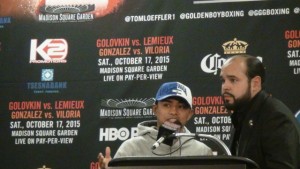Chocolatito City, part 1
By Bart Barry-

As 2016 approaches its final quarter still enjoying a fine chance at being remembered like the worst year for boxing in the 21st century there is little reason to pile on since we already all know the culprits and hopelessness of our current state. There is even less reason to begin a monthlong countdown to our sport’s one superfight of the year. Better then to assume so few of us accessed foreign broadcasts of Nicaraguan master Roman “Chocolatito” Gonzalez’s early career that visiting them will prove fruitful while knowing even if it doesn’t a late-arriving effort to celebrate Gonzalez brings more pleasure than available alternatives do.
On Jan. 14, 2008, Chocolatito (16-0, 16 KOs) matched himself with Japanese light flyweight Hiroshi Matsumoto (17-7-4, 8 KOs) at Bunka Gym in Kanagawa, Japan. Gonzalez wore royalblue satin trunks with “Visit Nicaragua” on their seat, either in the hopes an English-speaking audience uncertain what to do with “Visita” might be watching or, just as likely, Japanese aficionados in attendance would fault no one from America who did not inscribe his country’s name in kanji or hiragana or katakana, and would be literate enough in English to appreciate the goodfaith effort of the Nicaraguan Chamber of Commerce or whomever.
While it is impossible for a fighter to turn pro fully formed it is nearly as inconceivable a fighter who wasn’t fully formed learned enough in his career’s opening 16 prizefights to be perfect as Gonzalez was in his 17th had he not come into prizefighting fully formed. In the first month of 2008 Gonzalez bore a remarkable resemblance to the fighter he was earlier this month, 30 prizefights later. His match with Matsumoto was noteworthy for being Gonzalez’s second appearance outside Nicaragua (also his second appearance in Japan) and for being the first match of Gonzalez’s th’t Chocolatito did not win by knockout. Matsumoto’s finishing upright was attributable to Matsumoto’s selfknowledge more than any shortcoming of Chocolatito’s.
What strikes first the viewer is Gonzalez’s detachment from the act of bludgeoning another man – in this Gonzalez is most notably Central American, not Mexican; he has Dinamita Marquez’s efficiency with none of the Mexican’s contempt for an opponent. Which brings the most delicious juxtaposition found in a Gonzalez match: He is calibrated perfectly to an opponent he seems to regard dispassionately as a target, not a man. How, one wonders, can Gonzalez capture so quickly and ably another man’s physicality without hating him or loving him or envying him or pitying him? Here he resembles his mentor, Alexis Arguello, about whom it was often said Arguello did not find other men’s weaknesses and exploit them so much as he found other men’s strengths and did those things better too – if you made your living with a 1-2 Arguello gave you jab-cross better than you’d ever given it; if other men feared your bodypunching Arguello was your man for that as well.
As Chocolatito has added weight to his tiny frame he has become admired for his incredible activity and stamina, but watch him against a career volume puncher like Matsumoto, a southpaw to boot, and see the ease of Gonzalez’s adaptation – how comfortably he waits for Matsumoto’s aggressiveness to undo itself by sending the Japanese’s weight tumbling over his front knee (Volume Puncher City, as it were) and landing himself on Gonzalez’s uppercuts, a disproportionate number of which the Nicaraguan fired in their match’s first five rounds.
Like most volume punchers Matsumoto hadn’t a backup plan because volume punchers generally don’t; contrary to others’ misperceptions of them, volume punchers are intelligent men who find the one fighting style that complements their talents and dispositions well enough to make their livings as professional athletes, gainful employments that surprise former coaches and trainers who told them they were too slow or fat or small for the better athletes they later disarm and unman.
Matsumoto was pure volume puncher in the sense his absence of discouragement was a tool for discomfiting more gifted opponents much as his fists. You struck him and struck him and calculus told you he would break, and when he didn’t and didn’t and didn’t it began to worry you. But it didn’t worry Chocolatito. His offensive purity, the perfection of his technique, left in him as much or more volume and activity as Matsumoto and thrice the accuracy.
Gonzalez neither took a wrong step nor allowed one from Matsumoto in Chocololatito’s ongoing pursuit of perpetual motion, the elusive machinery the very best teachers try to instill in students and rarely do: pulling the left shoulder, extended by the jab, powers the cross that extends the right shoulder whose return snaps the left hook that cocks the right uppercut and so on, all fired by the hips that turn and plant the driving feet. Many of us get told “the best combination has no end” but Chocolatito somehow absorbed it well enough to inform his every motion – even in the molten madness of combat’s crucible – till the fiber of who he is as a professional athlete became inseparable from it.
There is nothing not discouraging about being struck hard and often in the face by a man who knows how, but Matsumoto’s reaction to finishing his career’s 24th match in an upright position evinced something otherwise and deeper: the elation of a man condemned to die and pardoned.
And while the unanimous and lopsided decision got read in his opponent’s native language Chocolatito stood poised in his unmarked face evincing nothing so much as detachment.
Bart Barry can be reached via Twitter @bartbarry